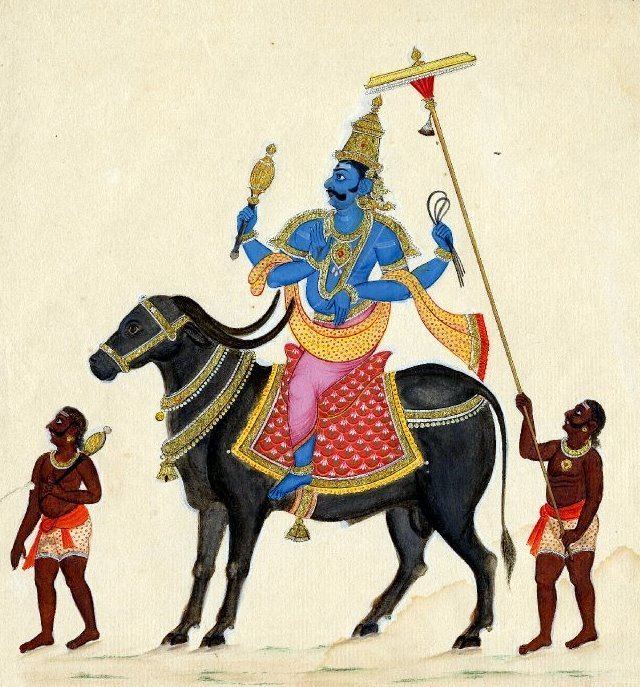Devanagari यम Abode Naraka Weapon Danda | Affiliation Deva Planet Pluto | |
 | ||
Mantra Om Surya puthraya Vidhmahe MahaKalaya Dheemahi Thanno Yama Prachodayath | ||
In Hindu Religion, Yama (Sanskrit: यम), is the lord of death. In the Rigveda, he is mentioned as one who helped humankind find a place to dwell, and gave every individual the power to tread any path to which s/he wants. In Vedic tradition, Yama was considered to be the first mortal who died and espied the way to the celestial abodes; thus, as a result, he became the ruler of the departed. Yama's name can be interpreted to mean "twin", and in some myths he is paired with a twin sister Yami.
Contents
Yama is associated with various roles in Hinduism that are not always consistent throughout the stories. Sometimes, he is the lord of justice and is associated with Dharma, such as in the Brahma Purana; in other Puranas, Yama has no association with Dharma at all. .
Yama is also found in Buddhist texts. The Buddhist Yama, however, has developed different myths.
Characteristics
Yama is the deity of death in Hinduism. In Hindu Puranic scriptures, those who assist him in his work are Kala (time), Jwara (fever), Vyadhi (disease), Krodha (anger) and Asuya (jealousy). He is one of the Lokapāla and represents the south cardinal direction. In different texts, Yama can be referred to as the god of justice, as the deity Dharma, or a completely different figure altogether.
In the Katha Upanishad, Yama is portrayed as a teacher to Nachiketa, the legendary little boy, and their conversation evolves to a discussion of the nature of humans, knowledge, Atman (soul, self) and moksha (liberation).
In the Epic Mahabharata, he is the father of Yudhishthira (also known as Dharmaraja), the oldest brother of the five Pandavas (Karna was born prior to Kunti's wedlock, so technically Karna is Yudhishthira's older brother) and is said to have incarnated as Vidura by some accounts in the Mahabharata period.
In other texts, Yama is called Kāla ("Time"), but so are other gods in Hindu pantheon, such as Shiva. the latter is also called Mahākāla ("Great Time") in his form as the destroyer of the world. Among the Nuristanis, the deity is known as Imra.
In the Rigveda
In the Rig Veda he is mentioned as the son of Vivasvat and of Saranya, the daughter of Tvastar, with a twin sister named Yami. Only three hymns (10.14, 10.135, and 10.154) in the Rig Veda are addressed to him. There is one other (10.10) consisting of a dialogue between Yama and his sister Yami. Yama's name is mentioned roughly fifty times in the Rig Veda, but almost exclusively in the first and (far more frequently) in the tenth book.
Agni, who is a conductor of the dead, has close relations with Yama. In RV 10.21.5 Agni is said to be the friend (kāmya) of Yama, and in RV 10.52 Agni is Yama's priest, serving as the burner of the dead. Agni, Yama, and Mātariśvan are mentioned together as the names of one being, along with other forms of the divine, in RV 1.164.46, which says that "learned priests call one by many names."
Iconography
In art, some Sanskrit sources say that he should be of dark color, resembling the rain-cloud, with two arms, fire-colored eyes and sharp side-tusks. He is depicted with red clothes (somewhere black cloths), and seated either on a lion throne or a he-buffalo. A different iconographic form described in the Viṣṇudharmottara depicts him with four arms and wearing golden yellow garments. He holds a noose (pāśa) of rope in one hand. He is also depicted holding a danda which is a Sanskrit word for "stick".
